Experimental Study on True Triaxial Mechanical Properties of Frozen Calcareous Clay under the Influence of Multiple Factors
Abstract
:1. Introduction
2. True Triaxial Test on Frozen Salted Calcareous Clay
2.1. Test Plan
2.2. Sample Preparation and Loading Mode
3. Test Results and Analysis
3.1. Stress–Strain Relationship Curve
3.2. Strength Characteristics and Analysis
3.2.1. Analysis of the Degree of Influence of Different Factors
3.2.2. Trend Analysis of Strength-Influencing Factors
3.2.3. Influence of Different Coefficients of Intermediate Principal Stress on Strength Characteristics of Calcareous Clay
3.2.4. Influence of Different Water Contents on Strength Characteristics of Calcareous Clay
4. Conclusions
- (1)
- The characteristics of the stress–strain curve of frozen calcareous clay can be approximately divided into three stages: (1) initial linear elastic stage: when the strain ε1 < 0.5% in the major principal strain direction, and the equivalent stress–strain curve is approximately linear. (2) plastic deformation stage: as the stress increases, the cementation between the clay particles and the ice crystals inside the sample becomes damaged, which manifests as the weakening of resistance to the sample’s deformation, and the tendency of stress to increase with strain begins to slow down. (3) Strain hardening failure stage.
- (2)
- Through the analysis of the orthogonal test results, the primary and secondary order of the factors influencing the strength was obtained. The primary and secondary order of influence σ1 is as follows: confining pressure σ3, water content ω, temperature T, medium principal stress coefficient b, salt content φ; The primary and secondary order of influence σ2 is as follows: middle principal stress coefficient b, confining pressure σ3, water content ω, temperature T, salt content φ. Under the influence of multiple factors, the strength of frozen soil in the real state is not independently affected by different factors whose influence is simply superimposed. Instead, the complex interactions of the various factors influence the strength.
- (3)
- The stress path significantly influences the stress–strain relationship of frozen calcareous clay. When the coefficient of intermediate principal stress b increased from 0 to 0.33, the large principal stress increased from 9.207 MPa to 10.847 MPa, which marks an increase of 15.12%; the principal stress coefficient b increased from 0.33 to 0.67; the large principal stress increased from 10.847 MPa to 11.067 MPa, which marks an increase of 1.99%; the middle principal stress coefficient b increased from 0.67 to 1; and the large principal stress increased from 11.067 MPa to 11.193 MPa, which marks an increase of only 1.13%. As the coefficient of intermediate principal stress b increased, its influence on the strength of the frozen specimen diminished and an optimal value existed. Specifically, the principal stress coefficient b = 0.33 maximized the strength of the specimen.
- (4)
- The influence of the moisture content on the strength of the sample is negatively correlated. The water content ω increased from 15% to 17.5%, and the large principal stress decreased from 11.193 MPa to 9.258 MPa, which marks a decrease of 17.29%. When the water content ω increased from 17.5% to 20%, the large principal stress decreased from 9.258 MPa to 7.855 MPa, which marks a decrease of 15.15%. The water content ω increased from 20% to 22.5%, which marks a decrease of 13.49%. As the moisture content ω increased, the strength of the sample continued to decrease, but the degree of influence weakened. Different moisture contents exerted different effects on the deformation and failure of unsaturated saline calcareous clay, but the difference did not exceed 5%.
Author Contributions
Funding
Institutional Review Board Statement
Informed Consent Statement
Data Availability Statement
Conflicts of Interest
References
- Mu, R.; Guo, J.; Huang, Z. Research on the influence of uneven water content on the shear strength of red clay. People’s Pearl River 2018, 39, 63–66. [Google Scholar]
- Zhao, R.; Zuo, S.; Wang, S. Triaxial shear strength test of Guiyang remolded red clay with different water content. Hydrogeol. Eng. Geol. 2015, 42, 90–95. [Google Scholar]
- Liang, B.; Mo, K. Research on the Shear Strength Characteristics of Remolded Red Clay under Different Moisture Contents. Shanxi Archit. 2010, 36, 101–102. [Google Scholar]
- Tang, L.; Yang, X.; Cha, X. Model test of shear strength relationship of remolded low liquid limit clay based on water content. J. Chang. Univ. Sci. Technol. Nat. Sci. Ed. 2021, 18, 26–32. [Google Scholar]
- Li, T.; Liu, B.; Yang, W. Experimental study on the influence of matrix suction on the shear strength of remolded red clay. J. Chin. Univ. Min. Technol. 2013, 42, 375–381. [Google Scholar]
- Huang, Z.; Chen, Y.; Song, R.; Song, L.J. Experimental study on unsaturated properties of loess-like silty clay in Sanmenxia area. Rock Soil Mech. 2010, 31, 1759–1762. [Google Scholar]
- Wang, D.; Luan, M.; Yang, Q. Study on the soil-water characteristic curve of reshaped unsaturated clay and its influencing factors. Rock Soil Mech. 2009, 30, 751–756. [Google Scholar]
- He, S.; Xue, K.; Hu, Y.; Zou, Y.L.; Chang, L.C.; Li, S. The influence of loading rate and ambient temperature on the rock mechanical properties of clay. Exp. Mech. 2018, 33, 757–768. [Google Scholar]
- Zhu, Q.; Yin, Z.; Zhu, J. Experimental study on the loading rate effect of soft clay: Progress and trends. Rock Soil Mech. 2014, 35, 7–24. [Google Scholar]
- Sheng, J.; Wu, C.; Ye, G. Study on strength characteristics of Shanghai clay by true triaxial test. Rock Soil Mech. 2013, 34, 47–52. [Google Scholar]
- Zhang, F.; Chen, X. Experimental study on deformation and strength characteristics of unsaturated clay. Chin. J. Rock Mech. Eng. 2009, 28, 3808–3814. [Google Scholar]
- Lu, J.; Xu, J.; Chen, Y. Experimental study on the effect of temperature on the consolidation and strength characteristics of silty clay. Chin. J. Disaster Prev. Mitig. Eng. 2017, 37, 598–603. [Google Scholar]
- Cheraghian, G.; Khalili Nezhad, S.S.; Bazgir, S. Improvement of Thermal Stability of Polyacrylamide Solution Used as a Nano-fluid in Enhanced Oil Recovery process by Nanoclay. Int. J. Nanosci. Nanotechnol. 2015, 3, 201–208. [Google Scholar]
- Chou, Y.; Jiang, X.; He, B. Experimental study on mechanical properties of frozen loess based on structure. J. Glaciol. Geocryol. 2014, 36, 913–921. [Google Scholar]
- Cai, Z.; Wu, Z.; Huang, Y. Experimental study on the influence of water content and salt content on the unconfined compressive strength of frozen soil. Chin. J. Geotech. Eng. 2014, 36, 1580–1586. [Google Scholar]
- Xiao, H. The relationship between the uniaxial compressive strength of artificial frozen soil and temperature and water content. Geotech. Eng. World 2008, 124, 62–63. [Google Scholar]
- Sun, L.; Lu, J.; Li, H. Experimental study on the influence of water content and salt content on the strength characteristics of artificial frozen soil. Chin. J. Geotech. Eng. 2015, 37, 27–31. [Google Scholar]
- Chen, J.; Li, D.; Bing, H. Experimental study on the influence of water content on the uniaxial compressive strength of frozen saline silt Chen Jin. J. Glaciol. Geocryol. 2012, 34, 441–446. [Google Scholar]
- Ma, H.; Zhang, F.; Feng, D.; Tang, K. Experimental study on frost heave of saturated silty clay under unidirectional freezing conditions. J. Build. Mater. 2016, 19, 926–932. [Google Scholar]
- Pharr, G.M.; Godavarti, P.S. A Comparison of the Creep Behavior of Saline Ice and Frozen Saline Ottawa Sand at a −8 °C. Cold Reg. Sci. Technol. 1987, 14, 273–279. [Google Scholar] [CrossRef]
- Chen, X. Experimental Study on the Characteristics of Instantaneous Unconfined Compressive Strength of Artificial Frozen Soil. Constr Techol. 1991, 6, 32–35. [Google Scholar]
- Ma, Q. Experimental study on uniaxial tensile and compressive strength of artificial frozen soil. Rock Soil Mech. 1996, 3, 76–81. [Google Scholar]
- Huang, X.; Li, D.; Ming, F. Experimental study on uniaxial compression and tensile strength characteristics of frozen soil. J. Glaciol. Geocryol. 2016, 38, 1346–1352. [Google Scholar]
- Hu, P.; Huang, M.; Ma, S. True triaxial test and strength characteristics of silty fine sand Hu Ping. Rock Soil Mech. 2011, 32, 465–470. [Google Scholar]
- Zhang, M.; Xu, C.; Du, X. True triaxial test study on the influence of Coefficient of intermediate principal stress and stress path on sand shear characteristics. J. Water Conserv. 2015, 46, 1072–1079. [Google Scholar]
- Dai, J.; Su, Z.; Zhao, M. Study on true triaxial test and strength characteristics of silty clay. Rock Soil Mech. 2016, 37, 2534–2546. [Google Scholar]
- Ma, S.; Yao, Z.; Liu, S. The damage constitutive model of frozen sand under the influence of Coefficient of intermediate principal stress_Ma Shilong. Coal Geol. Prospect. 2020, 48, 130–136. [Google Scholar]
- Yang, Y.; Lai, Y.; Li, S. Analysis of deformation failure and energy characteristics of frozen silt under triaxial compression. Rock Soil Mech. 2010, 31, 3505–3510. [Google Scholar]
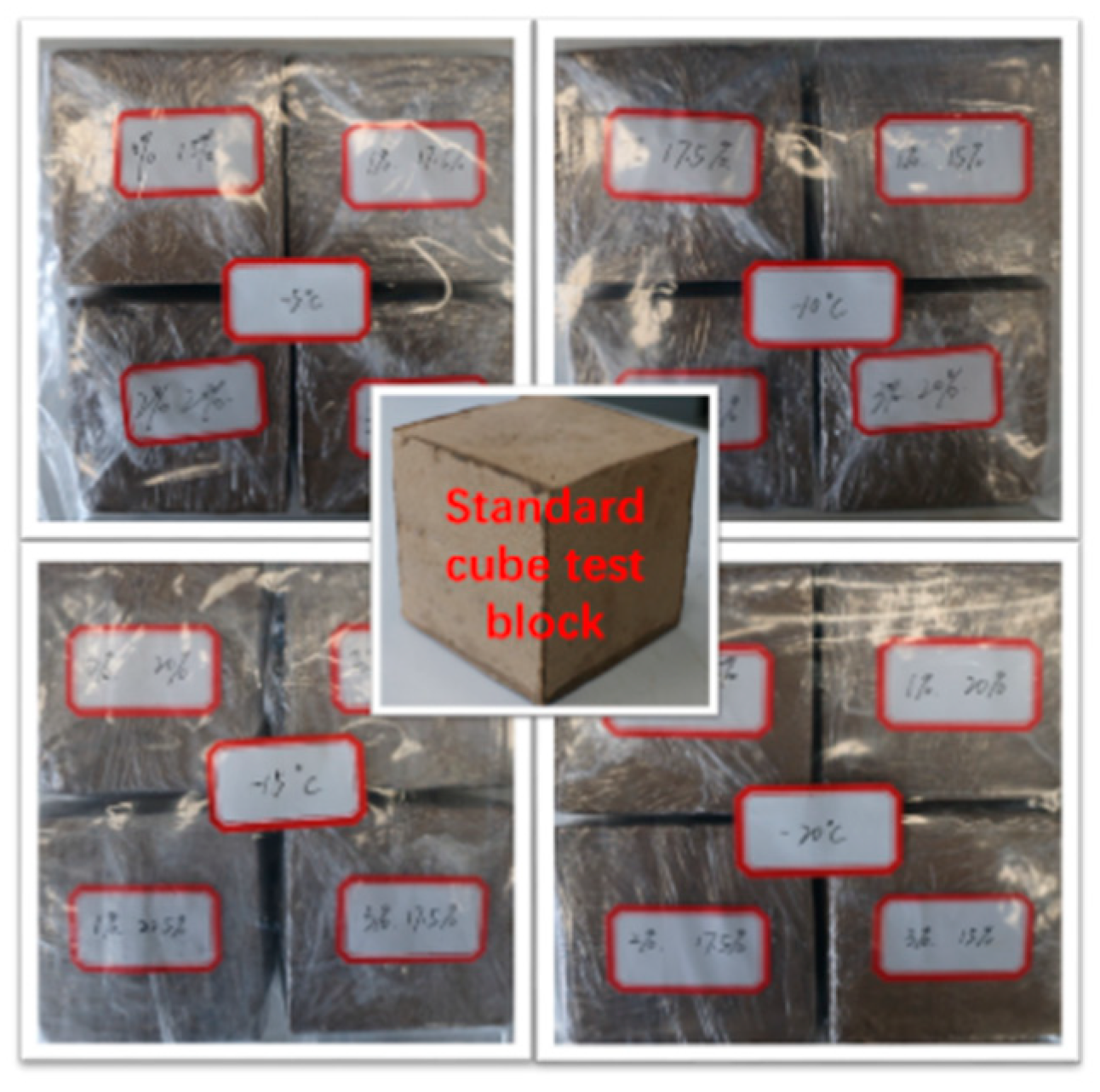
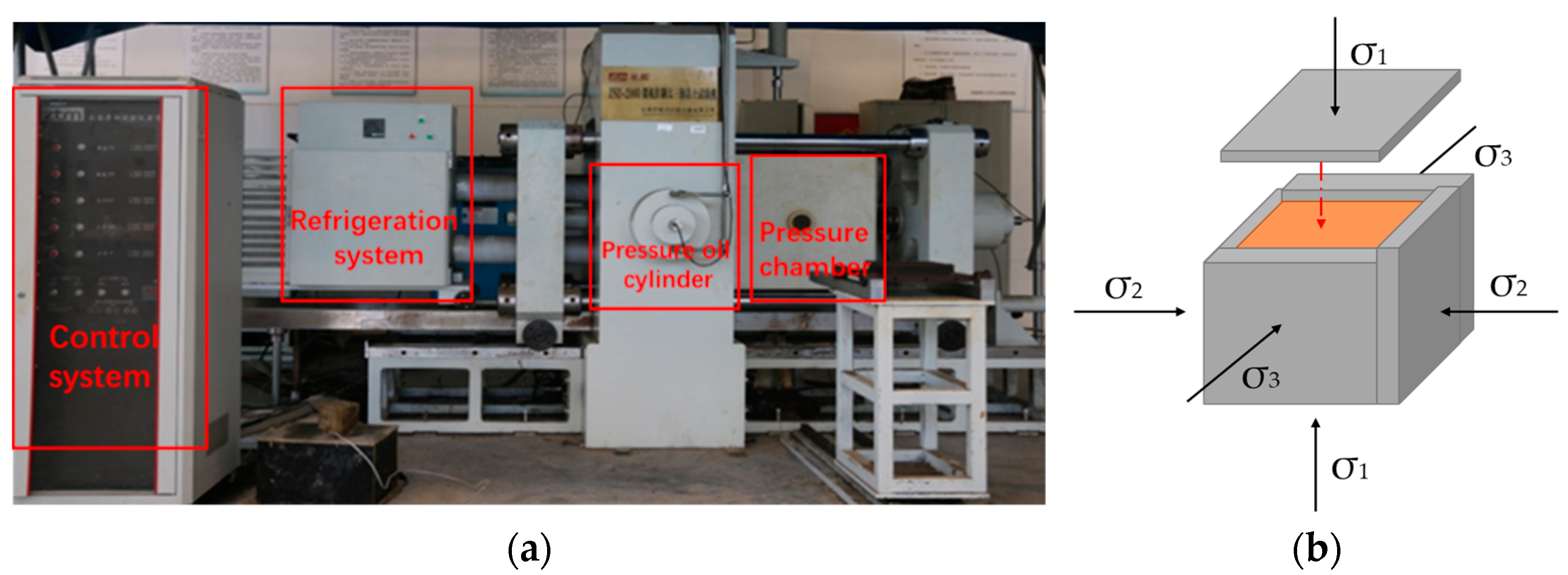
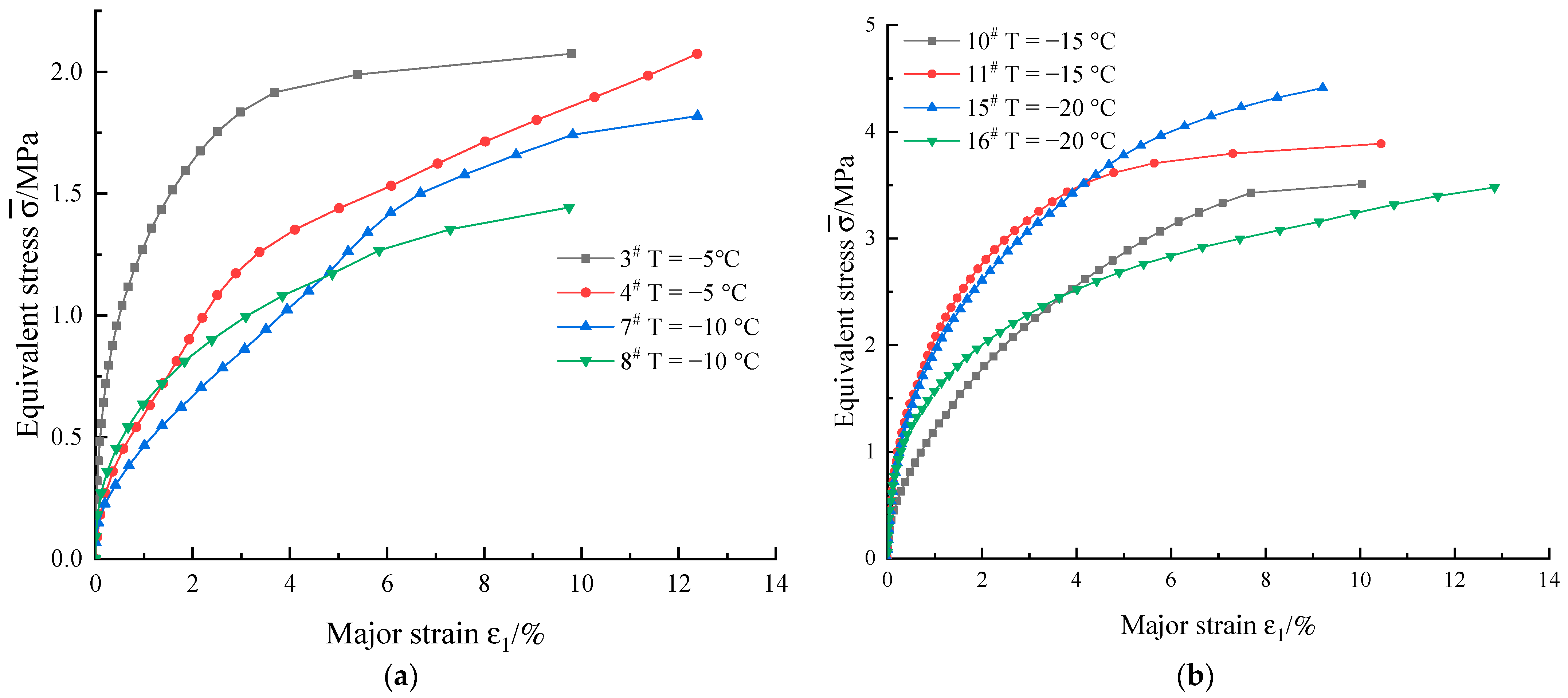

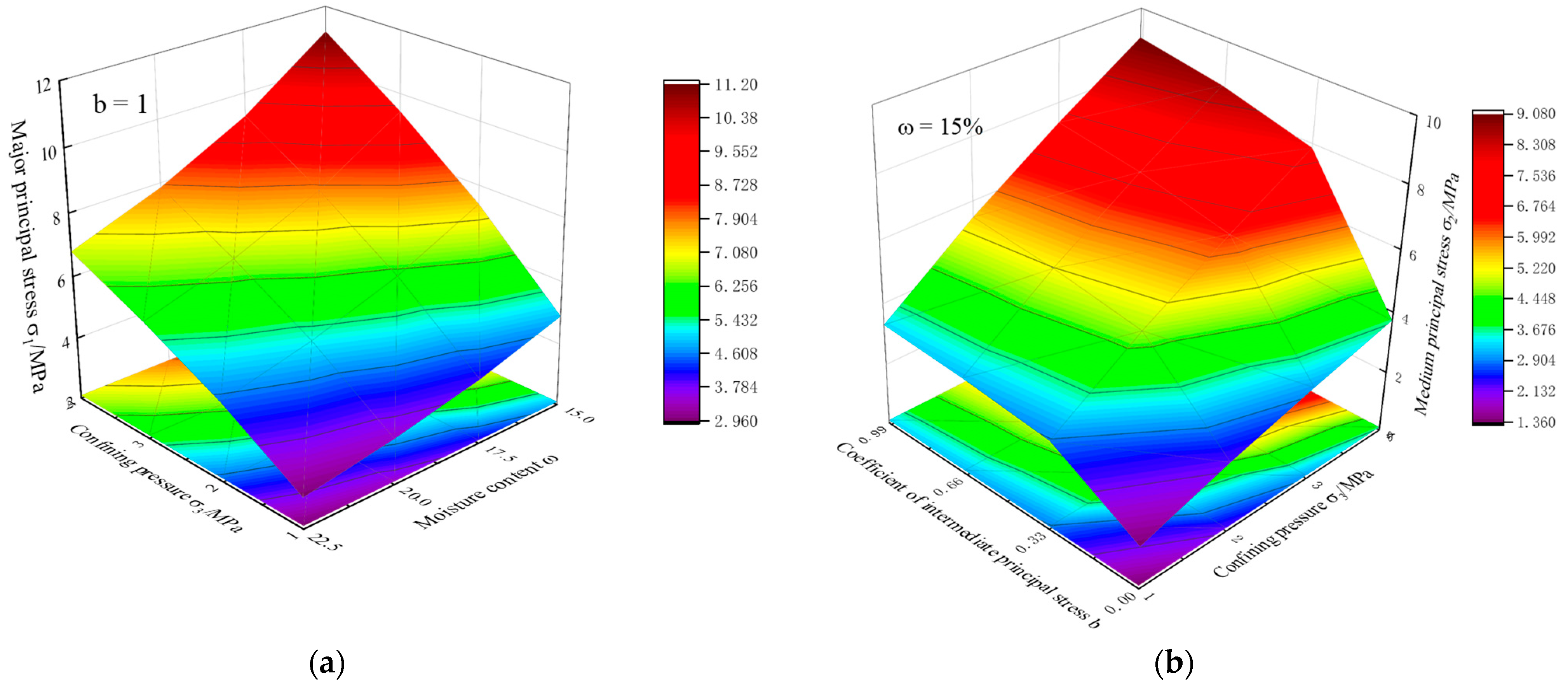
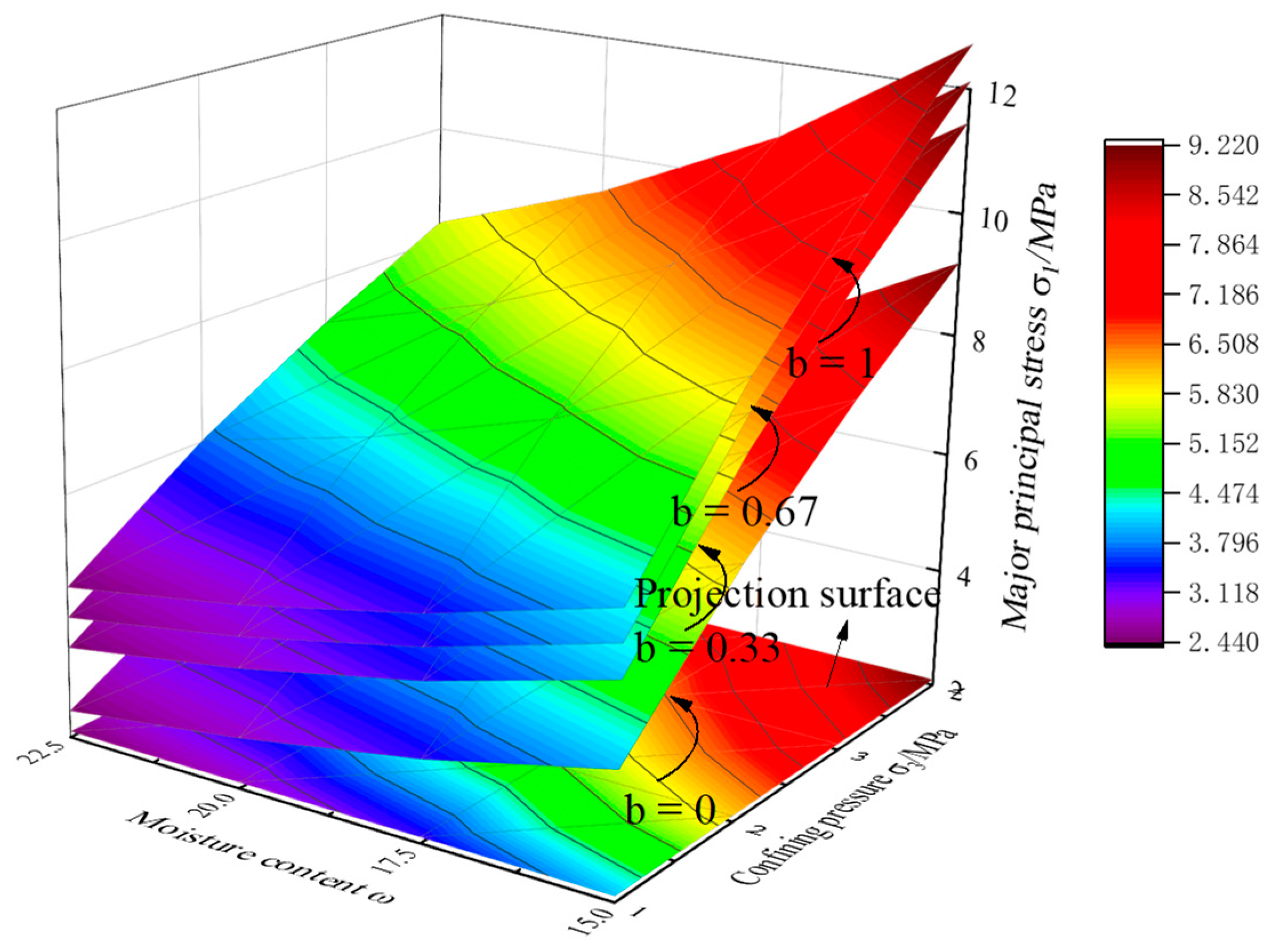



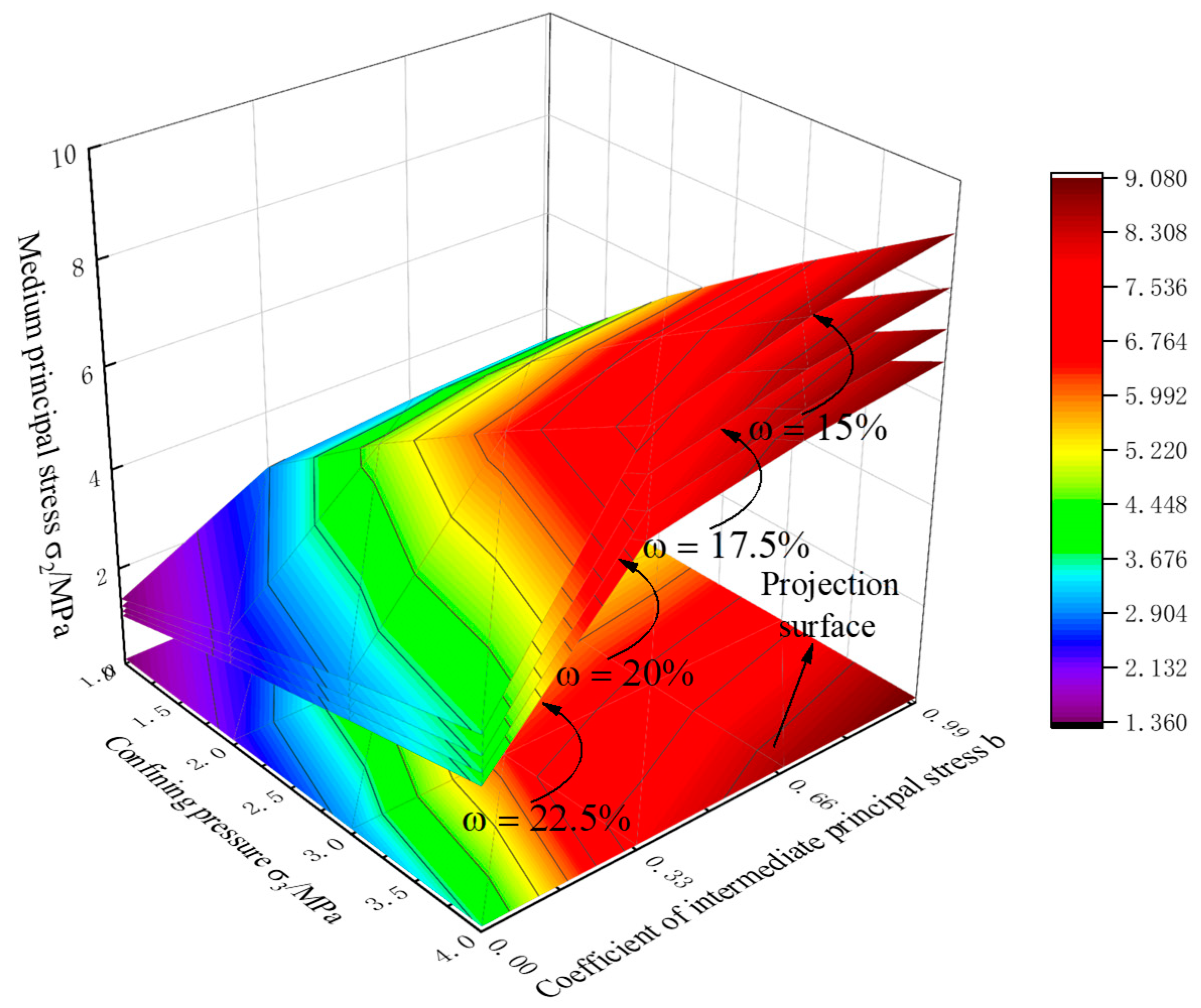
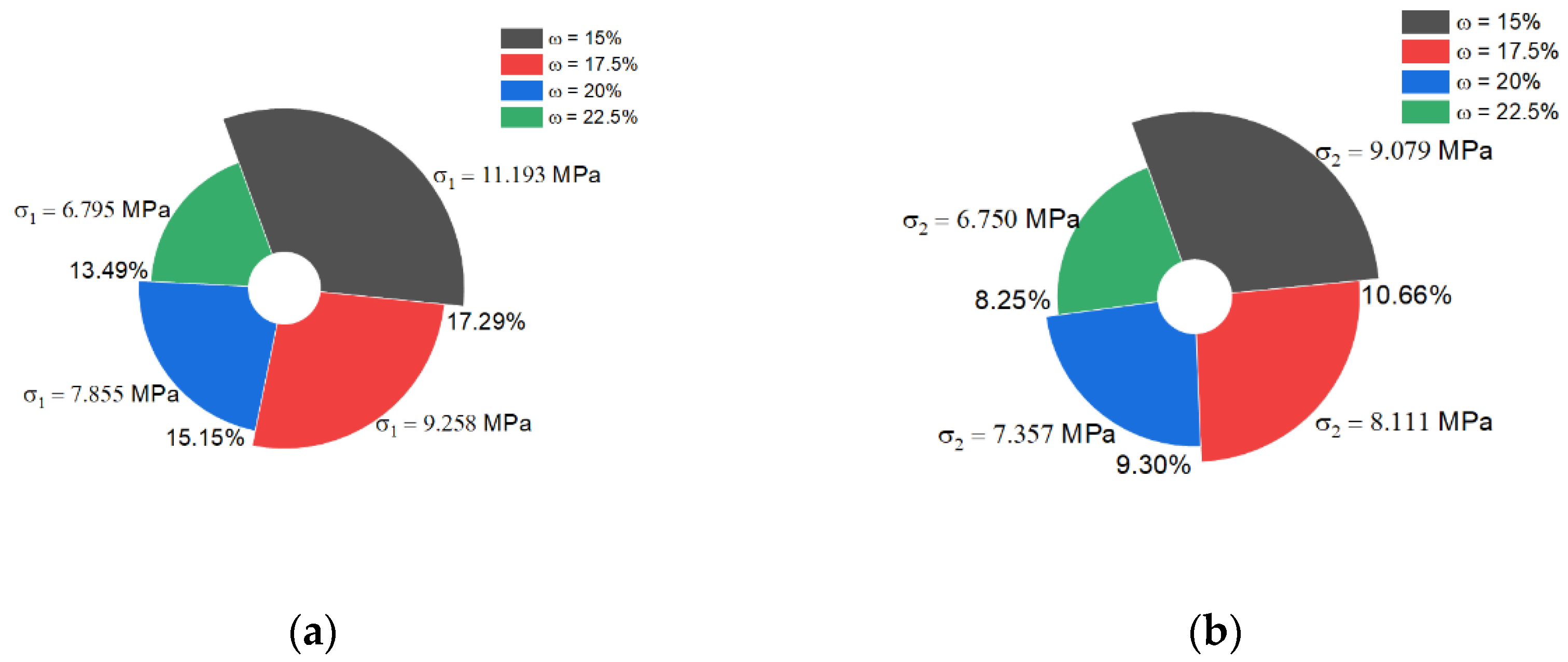
| Soil Type | Moisture Content ω (%) | Wet Density ρ (g/cm3) | Dry Density ρd (g/cm3) | Specific Gravity Gs | Void Ratio | Liquid Limit ωl (%) | Plastic Limit ωp (%) | Liquid Limit Index IL | Plastic Limit Index IP |
|---|---|---|---|---|---|---|---|---|---|
| Calcareous clay | 22.62 | 2.04 | 1.66 | 2.736 | 0.64 | 54 | 35 | −0.65 | 19 |
| 5 Factors | Temperature (A) | Moisture Content (B) | Salt Content (C) | Confining Pressure (D) | Coefficient of Intermediate Principal Stress b (E) | |
|---|---|---|---|---|---|---|
| 4 Levels | ||||||
| K1 | −5 °C | 15% | 0% | 1 MPa | 0 | |
| K2 | −10 °C | 17.5% | 1% | 2 MPa | 0.33 | |
| K3 | −15 °C | 20% | 2% | 3 MPa | 0.67 | |
| K4 | −20 °C | 22.5% | 3% | 4 MPa | 1 | |
| Test Number | Temperature T/°C | Moisture Content ω/% | Salt Content φ/% | Confining Pressure σ3/MPa | Coefficient of Intermediate Principal Stress b |
|---|---|---|---|---|---|
| 1# | −5 | 15 | 0 | 1 | 0 |
| 2# | −5 | 17.5 | 1 | 2 | 0.33 |
| 3# | −5 | 20 | 2 | 3 | 0.67 |
| 4# | −5 | 22.5 | 3 | 4 | 1 |
| 5# | −10 | 15 | 1 | 3 | 1 |
| 6# | −10 | 17.5 | 0 | 4 | 0.67 |
| 7# | −10 | 20 | 3 | 1 | 0.33 |
| 8# | −10 | 22.5 | 2 | 2 | 0 |
| 9# | −15 | 15 | 2 | 4 | 0.33 |
| 10# | −15 | 17.5 | 3 | 3 | 0 |
| 11# | −15 | 20 | 0 | 2 | 1 |
| 12# | −15 | 22.5 | 1 | 1 | 0.67 |
| 13# | −20 | 15 | 3 | 2 | 0.67 |
| 14# | −20 | 17.5 | 2 | 1 | 1 |
| 15# | −20 | 20 | 1 | 4 | 0 |
| 16# | −20 | 22.5 | 0 | 3 | 0.33 |
| Number | σ1max/MPa | Number | σ1max/MPa |
|---|---|---|---|
| 1# | 3.789 | 9# | 10.396 |
| 2# | 5.694 | 10# | 6.509 |
| 3# | 5.35 | 11# | 5.914 |
| 4# | 6.11 | 12# | 3.071 |
| 5# | 10.209 | 13# | 7.94 |
| 6# | 9.568 | 14# | 5.197 |
| 7# | 3.064 | 15# | 8.411 |
| 8# | 3.474 | 16# | 6.941 |
| Factor Level | A | B | C | D | E | Excellent Level | Factor Priority | |
|---|---|---|---|---|---|---|---|---|
| Major principal stress σ1max/ MPa | K1 | 5.236 | 8.083 | 6.553 | 3.780 | 5.546 | A4B1C2D4E4 | D > B > A > E > C |
| K2 | 6.579 | 6.742 | 6.846 | 5.755 | 6.524 | |||
| K3 | 6.473 | 5.685 | 6.104 | 7.252 | 6.482 | |||
| K4 | 7.122 | 4.899 | 5.906 | 8.621 | 6.857 | |||
| R | 1.886 | 3.184 | 0.940 | 4.841 | 1.311 | |||
| Factor Level | A | B | C | D | E | Excellent Level | Factor Priority | |
|---|---|---|---|---|---|---|---|---|
| Intermediate principal stress σ2max/ MPa | K1 | 3.728 | 5.823 | 4.737 | 2.570 | 2.500 | A2B1C2D4E4 | E > D > B > A > C |
| K2 | 5.406 | 4.790 | 4.954 | 4.279 | 3.827 | |||
| K3 | 4.351 | 4.044 | 4.473 | 5.523 | 5.171 | |||
| K4 | 4.873 | 3.700 | 4.194 | 5.987 | 6.860 | |||
| R | 1.678 | 2.123 | 0.760 | 3.417 | 4.360 | |||
| Coefficient of Intermediate Principal Stress b | Major Principal Stress σ1/MPa | Intermediate Principal Stress σ2/MPa | Confining Pressure σ3/MPa |
|---|---|---|---|
| 0 | 9.207 | 4 | 4 |
| 0.33 | 10.847 | 7.876 | |
| 0.67 | 11.067 | 8.622 | |
| 1 | 11.193 | 9.079 |
| Moisture Content ω | Major Principal Stress σ1/MPa | Intermediate Principal Stress σ2/MPa | Confining Pressure σ3/MPa |
|---|---|---|---|
| 15% | 11.193 | 9.079 | 4 |
| 17.5% | 9.258 | 8.111 | |
| 20% | 7.855 | 7.357 | |
| 22.5% | 6.795 | 6.750 |
Publisher’s Note: MDPI stays neutral with regard to jurisdictional claims in published maps and institutional affiliations. |
© 2022 by the authors. Licensee MDPI, Basel, Switzerland. This article is an open access article distributed under the terms and conditions of the Creative Commons Attribution (CC BY) license (https://creativecommons.org/licenses/by/4.0/).
Share and Cite
Cao, Y.; Rong, C.; Wang, Z.; Shi, X.; Wang, B.; Long, W. Experimental Study on True Triaxial Mechanical Properties of Frozen Calcareous Clay under the Influence of Multiple Factors. Crystals 2022, 12, 328. https://doi.org/10.3390/cryst12030328
Cao Y, Rong C, Wang Z, Shi X, Wang B, Long W. Experimental Study on True Triaxial Mechanical Properties of Frozen Calcareous Clay under the Influence of Multiple Factors. Crystals. 2022; 12(3):328. https://doi.org/10.3390/cryst12030328
Chicago/Turabian StyleCao, Yi, Chuanxin Rong, Zhi Wang, Xin Shi, Bin Wang, and Wei Long. 2022. "Experimental Study on True Triaxial Mechanical Properties of Frozen Calcareous Clay under the Influence of Multiple Factors" Crystals 12, no. 3: 328. https://doi.org/10.3390/cryst12030328






